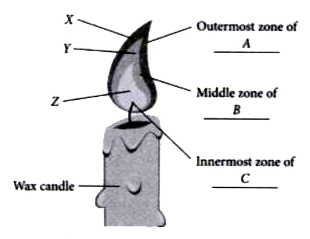A yellow flame on a burner shows _____ combustion.
To answer the question "A yellow flame on a burner shows _____ combustion," we can follow these steps:
1. Identify the Type of Flame:
- A yellow flame is typically observed in situations where there is a limited supply of oxygen.
2. Understand Combustion:
- Combustion is a chemical reaction that occurs when a substance (usually a fuel) reacts with oxygen to produce heat and light.
3. Types of Combustion:
- There are two main types of combustion: complete combustion and incomplete combustion.
- Complete combustion occurs when there is a sufficient supply of oxygen, resulting in the production of carbon dioxide and water.
- Incomplete combustion occurs when there is a limited supply of oxygen, leading to the formation of products like carbon monoxide, soot, and water vapor.
4. Analyze the Yellow Flame:
- The yellow flame indicates that the combustion is not complete due to the insufficient oxygen supply. This results in the production of soot (carbon particles) and other byproducts.
5. Conclusion:
- Therefore, a yellow flame on a burner shows incomplete combustion.
Final Answer:
A yellow flame on a burner shows incomplete combustion.
---
- A yellow flame is typically observed in situations where there is a limited supply of oxygen.
- Combustion is a chemical reaction that occurs when a substance (usually a fuel) reacts with oxygen to produce heat and light.
- There are two main types of combustion: complete combustion and incomplete combustion.
- Complete combustion occurs when there is a sufficient supply of oxygen, resulting in the production of carbon dioxide and water.
- Incomplete combustion occurs when there is a limited supply of oxygen, leading to the formation of products like carbon monoxide, soot, and water vapor.
- The yellow flame indicates that the combustion is not complete due to the insufficient oxygen supply. This results in the production of soot (carbon particles) and other byproducts.
- Therefore, a yellow flame on a burner shows incomplete combustion.
A yellow flame on a burner shows incomplete combustion.
Topper's Solved these Questions
- BOOK - S CHAND IIT JEE FOUNDATIONCHAPTER - COMBUSTION AND FLAME EXERCISE - Question Bank-17(Answer true or false)6videos
COMBUSTION AND FLAME
- BOOK - S CHAND IIT JEE FOUNDATIONCHAPTER - COMBUSTION AND FLAME EXERCISE - Question Bank-17(Answer the questions)10videos
COMBUSTION AND FLAME
- BOOK - S CHAND IIT JEE FOUNDATIONCHAPTER - COAL AND PETROLEUMEXERCISE - Self Assessment Sheet-1610videos
COAL AND PETROLEUM
- BOOK - S CHAND IIT JEE FOUNDATIONCHAPTER - HYDROGENEXERCISE - SELF ASSESSMENT SHEET28videos
HYDROGEN
Similar Questions
The type of combustion in which a material bursts suddenly into flame only own without application of any apparent cause, is called _____ combustion.
View SolutionStatement 1 : Unsaturated carbon compounds give yellow flame during combustion.
Statement 2 : Proportion of carbon is large in unsaturated compounds.
Using the Statement 1 explain Statement 2.View Solution
Knowledge Check
- Question 1 - Select One
The middle zone of a candle flame is also called the zone of _____ combustion.
AFullBIncompleteCCompleteDPartial - Question 2 - Select One
Assertion : The colour of LPG flame is blue while a candle flame is yellow.
Reason : LPG undergoes complete combustion while wax undergoes incomplete combustion.AIf both assertion and reason are true and reason is the correct explanation of assertion.BIf both assertion and reason are true but reason is not the correct explanation of assertion.CIf assertion is true but reason is false.DIf both assertion and reason are false. - Question 3 - Select One
_________ burn(s) with a yellow flame with a smell of burning hair.
ASilk and woolBCotton and rayonCNylon and polyesterDAcrylic
One of the burners in Misha's stove is giving off a yellow flame on the right side, but a normal blue flame elsewhere. The bottoms of her utensils are also turning black? What could be the problem? How can this be fixed?
View SolutionApparatus: Bunsen burner, copper gauze, metal plate, etc.
Chemicals : Ethanol, acetic acid, naphthalene
Procedure: Place one of the above chemicals (3-4 drops or a pinch) on clean copper gauze at room temperature, hold it on a blue flame of the Bunsen burner and observe.
Is smoke/soot seen to form due to combustion? Hold the metal plate on the flame when the substance is undergoing combustion. Does any diposit get collected on the plate? Which colour? Repeat the same procedure using other chemicals from the above list.View SolutionApparatus: Bunsen burner, copper gauze, metal plate, etc.
Chemicals : Ethanol, acetic acid, naphthalene
Procedure: Place one of the above chemicals (3-4 drops or a pinch) on clean copper gauze at room temperature, hold it on a blue flame of the Bunsen burner and observe.
Is smoke/soot seen to form due to combustion? Hold the metal plate on the flame when the substance is undergoing combustion. Does any diposit get collected on the plate? Which colour? Repeat the same procedure using other chemicals from the above list.View SolutionThe flame given out during complete combustion is ______ in colour.
View SolutionA flame is the visible gaseous part of a fire. It is a zone of combustion of gaseous substances accompanied by evolution of heat and light. All substances do not burn with a flame. Only those substances that vaporise during burning produce flame. A candle flame is taken to study the various zones of a flame.

Which zone of a candle flame is the zone of no combustion?View Solution

